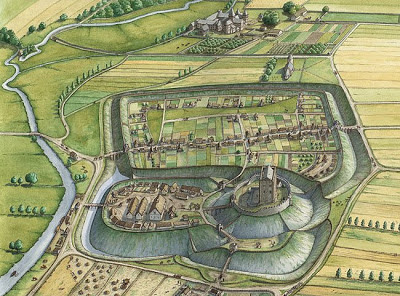A Typical Norman Town
Today we begin our second week of digging! As we get down to a possible Norman phase at the west end of Trench 8, we are hoping to discover additional remains of a Norman building, and
evidence of the Norman town of Berkeley. But just what does a Norman town look
like?
Existing towns were often levelled to make room for the central focus of a typical Norman town - the castle,
which was commonly placed beside a river such as at Nottingham or Chester.
Settlements tended to build up around the castle in a curving, semi-circular style that mimicked the castle defenses. These buildings were enclosed within the castle's walls and had gatehouses to the north and south, controlling traffic through the town.
Originally, the surrounding walls consisted of earthen banks and ditches, but
would later have been constructed of stone. In several town plans such as
in Swansea, the castle entrance is aligned to the two main streets in each
town, which run parallel to each other, and one of which was often widened to
accommodate a market place (Lilley and Dean, 2014).
 |
| An artist's impression of a Norman town (White, 2008). |
Some Norman towns were developed around existing Anglo-Saxon market places, but records show that Berkeley was referred to as "novo villa" or a "new town" in many historical deeds, as outlined by Smyth in his 1636 book Lives of the Berkeley's. This suggests that the majority of Berkeley was newly laid out by the Normans in the 11th-13th century. Further evidence of Berkeley's Norman origins can be seen in the regularity of the rear garden boundaries along the west side of the High Street. In towns developed around Saxon market places, town planning tended to be organic, ad hoc and disorganised, unlike the town plan seen at Berkeley.
A church or chapel is a typical
component of a Norman town; however many newly developed towns did not see the
construction of a Norman church until much later in their settlement. Instead,
pre-existing chapels were utilized, and initially were largely unaltered. Where new churches were built, they were mostly stone constructions, in contrast to most
domestic buildings at that time which would have been made of timber (Ellis, 2012). Many
towns also had a hospital, which was typically placed downriver of the town, beyond the outer walls, and would been run by
members of a nearby religious order (Potterton, 2017).
The purpose of a Norman town was primarily to colonise and control. The creation of a planned town provided an area in which the majority of 'burgesses' or residents of a borough were merchants and craftsmen, rather than farmers. In return for paying an annual sum for plots of land in the town and nearby fields, burgesses would receive protection from the outer walls, freedom to trade in the town markets without paying trading tolls, and various civil liberties (O'Donnell, 2003).
In 2013 at Dig Berkeley, we thought we had discovered a Norman house at the High Street end of Trench 8, but after discovering Tudor pottery in a pit that ran beneath one of the walls, it was realised that the building was actually later in date than Norman. However, we remain hopeful as a new east to west wall defined at the end of the 2017 season at the high street end of the trench may well prove to be of post-conquest date and could be the southern gable end of a Norman house. We are hoping to find evidence of interior building features, such as floors, hearths or remains of stone furniture. At present, finds of a Norman date have not yet been discovered this season, but as we dig further down and remove surrounding later features, we have hope that they will be forthcoming.
Bibliography |
| The Norman wall in trench 8 |
Ellis, S. (2012). How the Normans Changed England. British Heritage. Accessed 15/05/18. Available from https://britishheritage.com/how-the-normans-changed-england.
Lilley, K. and Dean, G. (2014). Norman Castle-Towns. Medieval Swansea. Accessed 15/05/18. Available from http://www.medievalswansea.ac.uk/en/context/norman-castle-towns.
O'Donnell, M. G. (2003). Anglo-Norman Towns. The Heritage Council. Accessed 21/05/18. Available from https://www.heritagecouncil.ie/unpublished_excavations/section17.html.
Potterton, M. (2017). On the Anglo-Norman Town. Royal Irish Academy. Accessed 21/05/18. Available from https://www.ria.ie/news/irish-historic-towns-atlas/michael-potterton-anglo-norman-town.
Potterton, M. (2017). On the Anglo-Norman Town. Royal Irish Academy. Accessed 21/05/18. Available from https://www.ria.ie/news/irish-historic-towns-atlas/michael-potterton-anglo-norman-town.
Comments
Post a Comment